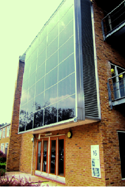|

Hybrid design solutions

BIPV double fašades
|
 |
Learning via Sharing building data
|
|
|
|
| Building data utilisation towards saving energy and improving the indoor environment |
|
Monitoring indoor climatic conditions and building services settings and performance and then sharing this information with the community can assist considerably energy reduction and indoor environmental quality.
IT approaches and digital technology may contribute further to the manufacturing of more practical energy saving software services which could also reduce the need for technicians to come by (leading also to further energy cuts in transport and technical support costs).
Energy performance contains eight impact criteria which are the following:
Energy, grid flexibility, self-generation, comfort, convenience, health & wellbeing, maintenance & fault prediction, user information provision.
What is required to achieve further energy savings and indoor quality is mainly the gathering, sharing and utilising of standards, knowledge, protocols plus procedures regarding cheap quality data.
For this purpose, today we have available centralised systems doing the monitoring, controlling plus recording the functions of building services. These are known as BACS (Building Automation and Control Systems).
The European committee on this front has prepared standard EN15232:2012: 'Energy performance of buildings - Impact of building automation, controls and building management' to be used in conjunction with the EPBD (Energy Performance of Buildings Directive).
The standard contains:
- a list of functions regarding control, automation and management
(i.e. related to indoor temperature, air quality, lighting, drivers and motors, monitoring, alarms, power management, diagnostics, central operations-settings, remote controls)
- a method to identify minimum requirements of those functions
- procedures to quantify performance
- a simple approach to gain an initial feel for what impact these functions may have
Thus to advance the level of control and operation of building services systems we need new digital tools like the following:
- IoT (Internet of Things) provides data on the status and activity of people and equipment.
- Artificial intelligence and data analytics that offer comprehensive energy performance assessments.
- Sharing economy platforms providing business models that connect energy software providers to the users.
So to access information-rich data at low cost we need an open exchange platform that enables software applications to scale rapidly (i.e. model predictive control-MPC, fault detection and diagnosis-FDD).
We then need a modelling framework - control oriented, that enables monitoring and analyses various HVAC control strategies within the digital environment integrated within energy efficiency software.
| |

The way to achieve higher energy efficiency and higher quality of our indoor environment through utilisation of buildings data and control strategies can be achieved in further detail by:
- Developing standards, protocols and procedures for collecting, sharing and utilising building data plus investigating open data concepts-governance-platforms-models for building apps.
- Developing and testing model predictive control applications.
- Developing building energy efficiency apps.
- Disseminating and adopting results of case studies, business models.
We are then able through all this shared knowledge and experience to replace our current approach on building control with a much more efficient and effective one in all fronts (energy, lighting quality, security, maintenance, fire, occupant comfort plus productivity).
In further detail:
- Time based maintenance may become condition based.
- Manual fault detection may become automated.
- Rule based control may become model predictive.
- Zone control may become task based.
- Complaint management may become customised comfort.
- Building services may become system services.
|
|
| |
|
|
|
|
|

Is nuclear viable? |
